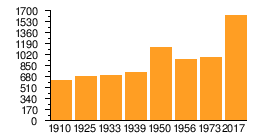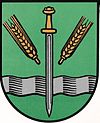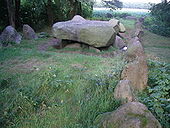Sievern
|
Sievern
City of Geestland
|
||
|---|---|---|
| Coordinates: 53 ° 38 ′ 49 ″ N , 8 ° 36 ′ 8 ″ E | ||
| Height : | 3 m above sea level NHN | |
| Area : | 16.31 km² | |
| Residents : | 1631 (June 30, 2017) | |
| Population density : | 100 inhabitants / km² | |
| Incorporation : | March 1, 1974 | |
| Incorporated into: | Long | |
| Postal code : | 27607 | |
| Area code : | 04743 | |
|
Location of Sievern in Lower Saxony |
||
|
Sievern in the city of Geestland
|
||

Sievern ( Low German Sievern ) is a village in the city of Geestland in the Lower Saxony district of Cuxhaven .
geography
location
The village on Landesstrasse 135 is north of the Langen district .
Neighboring places
|
Mulsum (municipality of Wurster North Sea Coast ) |
Holßel | Neuenwalde |
|
Wremen (municipality of Wurster North Sea Coast) |

|
Hymen village |
| Long | Debstedt |
(Source:)
history
Early history
In Sievern, there is evidence of a much earlier settlement in the area from around 3000 BC .
Concentrations of high -quality finds, including four gold hoards (gold bracteates ), and a concentration of fortified settlements from the late pre-Roman Iron Age, the Roman Empire, the Migration Period and the early Middle Ages, which is unique in the north German- south Scandinavian region, show that in the Sievern area during the 1st A power center existed for the millennium AD, which represented the political, economic and cultic center of the Elbe-Weser triangle. Sievern shows clear parallels to the central places or wealth centers such as Gudme (DK), Sorte Muld (DK) and Uppåkra (S) (recently also Füsing an der Schlei) that have been researched in southern Scandinavia in the past decades , without any statements about the structure in the current state of research of the Iron Age Sievern would be possible.
From the first mention until today
The place Sievern was mentioned for the first time in 1139 in a document of the Archbishop of Bremen Adalbero .
Sievern in the parish Debstedt formerly belonged to the Börde Debstedt and from 1768 to 1852 to the Bederkesa office . In 1840 the village got the status of a rural community. The affiliation of the community later changed to Amt Lehe (1852-1885), District Lehe (1885-1932), District Wesermünde (1932-1977) and District Cuxhaven .
In 1942 a farmer found twelve gold bracteates from the early 6th century while cutting peat .
The village with the weekend area Sieverner See , the attractions on the prehistory hiking trail and the location on the Alten Postweg is also a holiday resort.
The local homeworker of Sievern is Bernd Twachtmann and the local writer is Hermann Westedt.
Incorporations
In order to optimize the administrative structures, Sievern joined the Langen municipality from 1971 to 1974 as a member municipality.
In the course of the regional reform in Lower Saxony , which took place on March 1, 1974, Sievern belonged to the municipality of Langen and from July 1, 1990 to the city of Langen.
On January 1, 2015, Langen was incorporated into the city of Geestland, so that Sievern is now a locality of Geestland.
Population development
| year | 1910 | 1925 | 1933 | 1939 | 1950 | 1956 | 1973 | 2017 |
|---|---|---|---|---|---|---|---|---|
| Residents | 625 | 681 | 703 | 746 | 1136 | 943 | 982 | 1631 ¹ |
| source |
¹ according to the info box

|
politics
Local council
The Sievern local council consists of a councilwoman and six councilors from the following parties:
- CDU : 3 seats
- Citizens' group, WG in Geestland : 2 seats
- SPD : 1 seat
- Non-party : 1 seat
(Status: local election September 11, 2016)
Local mayor
The local mayor of Sievern is Rita Dehn (civic group, shared flat in Geestland). Your deputy is Reiner Feldmann (CDU).
coat of arms
The design of the Sievern municipal coat of arms comes from the heraldist and coat of arms painter Albert de Badrihaye , who designed around 80 coats of arms in the Cuxhaven district.
| Blazon : "In Green on erniedertem silver wave bar a slumped silver sword in Frankish shape with a golden handle, beseitet by a respective inclined golden ear of corn ." | |
| Justification of the coat of arms: The wavy bar indicates the floodplain . A Franconian sword was found in Sievern and is said to point to the Pipinsburg . The ears of corn are symbols of agriculture , the main branch of the community. |
Culture and sights
Architectural monuments
Natural monument
The Pipinsburg rises on the Sieverner Auetal as a mighty circular wall. This castle was built during the Norman invasion. The exact age is unknown. Nearby there are other places of worship with Bülzenbett and Heidenschanze bei Sievern (burial mound).
museum
The John Wagener House is privately owned.
sports clubs
The TSV Sievern from 1911 e. V. offers: yoga, badminton, soccer, gymnastics / bokwa / zumba, swimming and table tennis. The first men's soccer team was represented in the Lower Saxony league, the highest division in Lower Saxony, until 2002. In youth football there is a syndicate with TSV Holßel and TSV Neuenwalde. There is at least one team in each age group.
Personalities
Sons and daughters of the place
- John-Andreas Wagener , also John Wagener (1816–1876), American emigrant, General of the Confederate States of America , from 1871 Mayor of Charleston (South Carolina) , he helped German immigrants in Charleston by creating numerous associations, the publication of a German one Newspaper, by building a German church with a school and by acquiring fertile farmland to form a community, the new local history museum John-Wagener-Haus was named after him in 1994
- Wilhelm F. Huck , also William Huck (1899–1983), emigrant to America, shipbuilder, Vice-President for mechanical engineering in the USA, he was buried in the Sieverner cemetery
People connected to the place
- Johann Jakob Hoops (1840–1916), Bremen pedagogue, at the age of only 14 he was an assistant teacher in Sievern
- Hans Gummel (1891–1962), prehistorian and museum director, the focus of his scientific work was on the history of antiquity, he published, among other things, on the gold bracteates of Sievern
- Friedrich Huck (* 1936), electrical engineer, NASA employee, he was a. a. responsible for potential Apollo landing sites on the moon, he grew up in Sievern
Myths and legends
- The witch of Sievern
Literature on early history
- Karl Hauck : Gold bracteates from Sievern. Late antique amulet pictures of the "Dania Saxonica" and the Saxon "Origo" at Widukind von Corvey . In: Münstersche medieval writings . tape 1 . Fink Verlag, Munich 1970.
- Matthias D. Schön: Grave finds from the Roman Empire and Migration Period near Sievern, district of Cuxhaven . Ed .: Lower Saxony Institute for Historical Coastal Research (= Problems of Coastal Research in the Southern North Sea Area . Volume 27 ). Isensee Verlag, Oldenburg 2001, ISBN 978-3-89598-878-3 , p. 75-248 .
- Wolf Haio Zimmermann : Sievern . 1. Archaeological (= Johannes Hoops, Heinrich Beck, Dieter Geuenich [Hrsg.]: Reallexikon der Germanischen Altertumskunde . Volume 28 ). 2nd Edition. De Gruyter Verlag, Berlin / New York 2005, ISBN 3-11-018207-6 , pp. 368-374 .
Web links
- Internet presence of the village of Sievern on the website of the city of Geestland
- Website of the traffic association Sievern e. V.
Individual evidence
- ↑ a b Lower Saxony State Administration Office (ed.): Community directory for Lower Saxony . Municipalities and municipality-free areas. Self-published, Hanover January 1, 1973, p. 48 , Wesermünde district ( digitized [PDF; 21.3 MB ; accessed on August 6, 2020]).
- ↑ Overview map of the Cuxhaven district. In: cuxland-gis.landkreis-cuxhaven.de. November 2016, accessed August 6, 2020 .
- ↑ Sievern village. In: Website City of Geestland. Retrieved August 6, 2020 .
- ↑ Local homeland caretaker and local chronicle. In: Website City of Geestland. Retrieved August 6, 2020 .
- ^ Fritz Hörmann, Ude Meyer, Christian Morisse, Eberhard Nehring, Irmgard Seghorn, Egon Stuve, Else Syassen: Field names collection Wesermünde - The field names of the property tax cadastre from 1876 . Ed .: Kulturstiftung der Kreissparkasse Wesermünde (= new series of special publications by the men from Morgenstern , Heimatbund an Elb- und Wesermuende eV Volume 27 ). Men from Morgenstern Verlag, Bremerhaven 1995, ISBN 3-931771-27-X , p. 19 ([ digitized version ( memento of October 26, 2007 in the Internet Archive )] [PDF; 431 kB ; accessed on October 23, 2019]).
- ^ Federal Statistical Office (ed.): Historical municipality directory for the Federal Republic of Germany. Name, border and key number changes in municipalities, counties and administrative districts from May 27, 1970 to December 31, 1982 . W. Kohlhammer, Stuttgart / Mainz 1983, ISBN 3-17-003263-1 , p. 249 .
- ^ Law on the reorganization of the city of Geestland, district of Cuxhaven . In: Niedersächsische Staatskanzlei (Ed.): Niedersächsisches Gesetz- und Verordnungsblatt (Nds. GVBl.) . No. 26/2012 . Hanover November 8, 2012, p. 430 , p. 4 ( digitized version ( memento of July 10, 2018 in the Internet Archive ) [PDF; 454 kB ; accessed on August 6, 2020]).
- ^ Ulrich Schubert: Register of local authorities Germany 1900 - Lehe district. Information from December 1, 1910. In: gemeindeververzeichnis.de. January 5, 2020, accessed August 6, 2020 .
- ↑ a b c Michael Rademacher: German administrative history from the unification of the empire in 1871 to the reunification in 1990. Wesermünde district ( see under: No. 77 ). (Online material for the dissertation, Osnabrück 2006).
- ↑ a b Statistisches Bundesamt Wiesbaden (ed.): Official municipality register for the Federal Republic of Germany - 1957 edition (population and territorial status September 25, 1956, for Saarland December 31, 1956) . W. Kohlhammer, Stuttgart 1958, p. 193 ( digitized version ).
- ↑ a b The local council of Sievern. In: Citizen Information System City of Geestland. Retrieved August 6, 2020 .
- ↑ a b Landkreis Wesermünde (Ed.): Coat of arms of the Landkreis Wesermünde . Grassé Offset Verlag, Bremerhaven / Wesermünde 1973, ISBN 3-9800318-0-2 .
- ↑ Information about Sievern. (No longer available online.) In: Website Ferienort Sievern. Archived from the original on March 21, 2011 ; accessed on May 17, 2019 .
- ↑ a b c Famous emigrants from Sievern. In: Website of the Sievern resort. 2018, accessed August 6, 2020 .
- ^ Gravestones - Sievern Cemetery (Geestland, Cuxhaven). In: grabsteine.genealogy.net. 2011, accessed August 6, 2020 .





